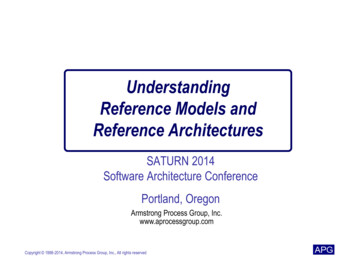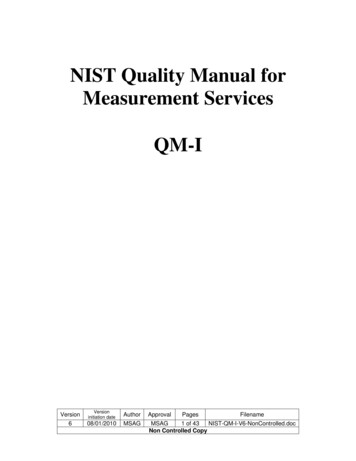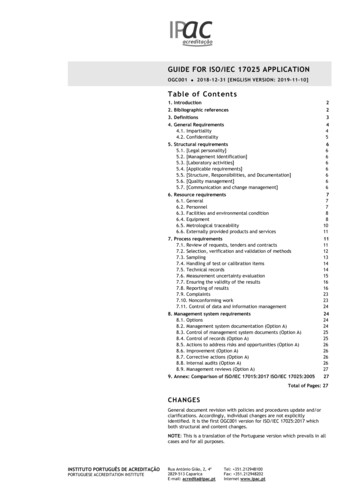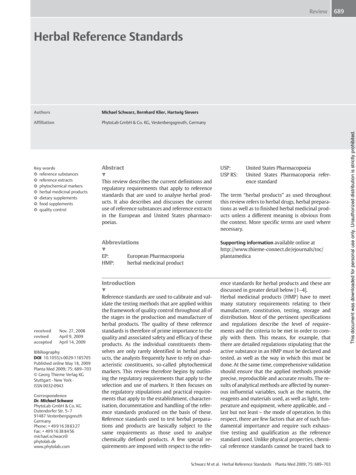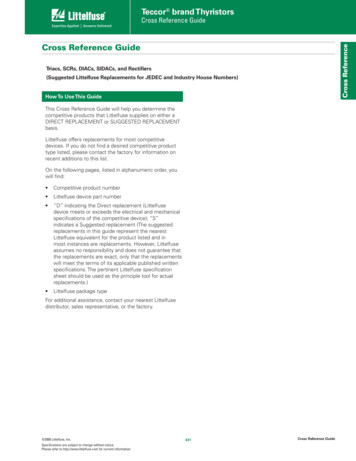
Transcription
FITNESSGRAM /ACTIVITYGRAMReference Guide (4th Edition)EditorsSharon A. Plowman and Marilu D. MeredithSuggested citations from this source:Reference to a chapter (sample) in the book:Plowman, S.A. (2013). Muscular Strength, Endurance, and Flexibility Assessments. In S. A. Plowman &M.D. Meredith (Eds.), Fitnessgram/Activitygram Reference Guide (4th Edition) (pp. Internet Resource).Dallas, TX: The Cooper Institute, 8-1 - 8-55.Reference to the whole book:Plowman, S.A. & Meredith, M.D. (Eds.). (2013). Fitnessgram/Activitygram Reference Guide (4th Edition).Dallas, TX: The Cooper Institute.Document Navigation:At the bottom of each page two links will assist in navigating this document: TOC ‐ links back to the Table of Contents Chapter ‐ links back to the beginning of the current Chapter
FITNESSGRAM / ACTIVITYGRAM Reference GuideChapter 1 - The History of FITNESSGRAM . 1-1(Plowman, Meredith, Sterling, Corbin, Welk, and Morrow)Chapter 2 – Why Test? Effective Use of Fitness and ActivityAssessments . 2-1(Corbin, Lambdin, Mahar, Roberts, and Pangrazi)Chapter 3 - Health Benefits of Physical Activity andFitness in Youth. 3-1(Eisenmann, Welk, Morrow, and Corbin)Chapter 4 – Physical Fitness Standards for Children . 4-1(Morrow, Zhu, and Mahar)Chapter 5 - Physical Activity Assessment . 5-1(Welk, Mahar, and Morrow)Chapter 6 - Aerobic Capacity Assessments . 6-1(Cureton, Plowman, and Mahar)Chapter 7 – Body Composition Assessments . 7-1(Going, Lohman, and Eisenmann)Chapter 8 - Muscular Strength, Endurance, and FlexibilityAssessments . 8-1(Plowman)Chapter 9 - Interpreting FITNESSGRAM and ACTIVITYGRAM Reports . 9-1(Meredith, Lambdin, Roberts, Welk, and Morrow)Copyrighted material. All rights reserved.2The Cooper Institute, Dallas, TX.
FITNESSGRAM / ACTIVITYGRAM Reference GuideChapter 1The History of FITNESSGRAM Sharon A. Plowman, Marilu D. Meredith, Charles L. Sterling, Charles B. Corbin,Gregory J. Welk, James R. Morrow, Jr.Abstract . 1-1Introduction . 1-1A Commitment to Health-Related Physical Fitness . 1-3A Concentration on Criterion-Referenced Standards (CRS) . 1-10A Consistent Emphasis on Fitness Behavior/Physical Activity . 1-12Systematic Updating and Sophistication of the ComputerizedReporting System . 1-13Conclusion . 1-19Bibliography . 1-20(Note: This manuscript is an update of a previously published article: Plowman, S.A., Sterling,C.L., Corbin, C.B., Meredith, M.D., Welk, G.J., and Morrow, J.R., Jr.: (2006). The History ofFITNESSGRAM . Journal of Physical Activity & Health, 3 (Supplement 2), S5-S20.Additions/modifications made with permission of the publisher, Human Kinetics, Champaign, IL TOCCopyrighted material. All rights reserved. Chapter1-1The Cooper Institute, Dallas, TX.
FITNESSGRAM / ACTIVITYGRAM Reference GuideAbstractInitially designed by Charles L. Sterling as a physical fitness “report card,”FITNESSGRAM is now the educational assessment and reporting software portion of thePresidential Youth Fitness Program. Based on physiological/epidemiological, behavioral, andpedagogical research, FITNESSGRAM is committed to health-related physical fitness,criterion-referenced standards, an emphasis on physical activity, and the latest in technology.The evolution of these major concepts including the inclusion of ACTIVITYGRAM andNUTRIGRAM is described in this history of FITNESSGRAM .IntroductionThe concept for FITNESSGRAM had its beginning in 1977 when Charles L. Sterling,Ed.D., the Director of Health and Physical Education of the Richardson, Texas school system,recognized school administrators’ and parents’ interest in a physical fitness “report card” similarto those used in other educational areas. He also recognized the potential for using computers toprint reports and keep student records. Sterling and teachers Marilu Meredith, Nancy Voith,Cindy Raymond, and Don Rainey administered the Texas Physical Fitness—Motor Ability Test(Governor’s Commission on Physical Fitness, 1972) in their schools. Personalized fitness reportcards were then generated for all students using customized software developed for the schooldistrict’s mainframe computer.In 1981, Dr. Sterling joined the staff of the Cooper Institute for Aerobics Research(CIAR/IAR/CI) in Dallas. The Institute had a mainframe computer that allowed batch processingof the physical fitness reports. This created the opportunity to take the concept to a wideraudience, but a name was needed. FITNESSGRAM was chosen through a contest in the localschool district—Nancy Voith is credited with the winning entry. This name played off theconcept of a telegram and suited the intended purpose of the report—namely, to communicateimportant fitness information to children and parents. The Campbell Soup Company’s Institutefor Health and Fitness signed on as a national sponsor to support the promotion anddissemination of the tool. Dr. Marilu Meredith was hired as National Project Director in 1982, aposition she held until 2012. At that time Dr. Meredith became the Director of the PerotInternational Youth Data Repository with part-time FITNESSGRAM duties. In 2013 CatherineVowell assumed the directorship of FITNESSGRAM .FITNESSGRAM (FG) was implemented in phases with the first pilot conducted in 30schools in the Tulsa, Oklahoma School District (1982-83) using the AAHPERD Youth FitnessTest (YFT) (American Alliance for Health, Physical Education, and Recreation [AAHPER],1976; Lacy & Marshall, 1984; Razor, 1984). In the second year (1983-84), approximately 125schools throughout Oklahoma participated and were able to select either the AAHPERD YFT orthe AAHPERD Health Related Fitness Test (HRPFT) (American Alliance for Health, PhysicalEducation, Recreation and Dance [AAHPERD], 1980). After these successes, FG wasimplemented on a national basis first as a pilot, one district per state in addition to OK (1984-85),and then unrestricted (1985-86).Now, in 2013, FITNESSGRAM /ACTIVITYGRAM (FG) is an educationalassessment and reporting software system that has been used by thousands of teachers withmillions of youth in schools worldwide to help teachers track health-related fitness and physicalactivity information over time and produce personalized reports for children, parents, and schooladministrators. In conjunction with a variety of partners, FG has pushed the evolution of physical TOCCopyrighted material. All rights reserved. Chapter1-2The Cooper Institute, Dallas, TX.
FITNESSGRAM / ACTIVITYGRAM Reference Guidefitness and physical activity philosophy, research, evaluation, education, and promotion. Thisevolution has occurred in four major areas:1. A commitment to the concept of health-related physical fitness,2. A concentration on criterion-referenced evaluation in place of percentilenorm-referenced evaluation,3. A consistent emphasis on fitness behavior/physical activity, and4. Systematic updating and sophistication of the computerized reportingsystem.A Commitment to Health-Related Physical FitnessAt its inception FG was not a test battery. The route to embracing the current healthrelated battery reflects the basic changes that were made in the last half of the twentieth centuryin the concept of physical fitness.The history of youth physical fitness testing from approximately the 1860s to 1988 isdescribed in a government document prepared by Roberta Park (1988) and much of it need notbe repeated here. Suffice it to say that since its inception in 1885, the organization now known asthe American Alliance for Health, Physical Education, Recreation and Dance(AAHPER/AAHPERD) was deeply concerned with the physical fitness of American youth.Formal governmental involvement began in 1956 when President Dwight David Eisenhowerestablished the President’s Council on Youth Fitness (PCYF) [name later changed to President’sCouncil on Physical Fitness (PCPF), then the President’s Council on Physical Fitness and Sports(PCPFS) and now the President’s Council on Fitness, Sports and Nutrition (PCFSN)] in responseto published data that American children were less fit than European children (Kraus &Hirschland, 1953; 1954). Shortly thereafter the Research Council of AAHPER agreed on abattery of tests and the AAHPER Youth Fitness Project, a nationwide pilot study of the fitnesslevels of 5-12 year old boys and girls headed by Dr. Paul Hunsicker, was completed. As a resultthe AAHPER YFT Manual with national norms was published in 1958. The test items includedpull-ups for boys/ modified pull-ups for girls, straight leg sit-ups, shuttle run, standing broad(long) jump, 50-yd dash, softball throw for distance, 600-yd run/walk, and three aquatic tests thatwere rarely used. In 1966 the then President’s Council on Physical Fitness, at the direction ofPresident Lyndon Johnson, established a Presidential Award Program based on AAHPER’sYFT. Criteria for this award for youngsters between 10 and 17years included being in goodacademic standing, a recommendation from the school principal, and scoring in the 85thpercentile on all seven items. Between 1958 and 1975 minor changes were made in the test itemsand norms (AAHPER, 1965). However, by the early 1970s there was mounting dissatisfactionwith the actual test items and philosophy behind the test and award program from bothpractitioners and researchers. In 1972-73, the Texas Physical Fitness-Motor Ability Test(Governor’s Commission on Physical Fitness, 1972) was developed. At the same time a jointcommittee from the Measurement and Evaluation Council (MEC) and Physical Fitness Council(PFC) of AAHPER, chaired by Dale Mood and then Mike Reuter, was put in place to“recommend appropriate activities concerning testing of components of physical fitness” (D.Mood, personal communication, November 14, 1972). The committee was usurped when a smallgroup of AAHPER and PCYF people, apparently at the initiation of the AAHPER staff, changedthe YFT. The Texas distance run items and norms were incorporated as options, the Californiaversion of a one minute flexed knee sit-up replaced the straight leg sit-up, and the softball throw TOC Copyrighted material. All rights reserved. Chapter1-3The Cooper Institute, Dallas, TX.
FITNESSGRAM / ACTIVITYGRAM Reference Guidefor distance was deleted for the 1975 AAHPER Youth fitness survey (and 1976 publishedmanual) (AAHPER, 1976).In 1975, a joint committee was established to systematically study whether the AAHPERYFT needed major revision. Don Franks, Frank Katch, Vic Katch, Sharon Plowman, Margaret J.Safrit, and Andrew Jackson (chairperson), representing the MEC, PFC, and Research Council(RC, later renamed Research Consortium) of AAHPER, comprised the committee. Dr. RayCiszek attended the meetings as the AAHPER staff liaison and Dr. Ash Hayes was invited torepresent the PCPFS (AAHPER, 1977; Plowman & Falls, 1978; Plowman & Falls, 1979). Afterextensive review of the literature, much discussion, open hearings at the 1976 nationalconvention, and solicitation of opinions from colleagues, A Position Paper on Physical Fitnesswas submitted to AAHPER. This position paper called for a revision of the AAHPER YFT andset as a basic goal the relating of physical fitness to functional health and not sport performance.A six member Task Force on Youth Fitness was appointed in 1977 to implement the proposalsmade in the position paper. Members of this task force included Steven Blair, Charles Corbin(who resigned after the initial meeting and contributions; replaced by Don Franks), Andrew(Tony) Jackson, Michael Pollock, Margaret (Jo) Safrit, and Harold Falls (chairperson). RayCiszek served as the AAHPER staff consultant (AAHPER, 1977; Plowman & Falls, 1978;Plowman & Falls, 1979; AAHPER, 1978). Throughout 1978 the task force established goals andgathered information. Consultants, who joined the task force members for the 1979 meetings tofinalize the test items, identify normative sources and establish norms, and write the manual,included Charles Dotson, Dennis Humphrey, Tim Lohman, Russ Pate, Sharon Plowman, andGlen Swengros (PCPFS) (Plowman & Falls, 1979; Falls, 1979). Additional input was obtainedfrom Gary Krahenbuhl, William Stone, Kirk Cureton, Robert Serfass, Ed Burke, Frank Katch,Vic Katch, and Ash Hayes (AAHPERD, 1980). The components and items agreed upon werecardiorespiratory function (1 mi/9 min or 1.5mi/12 min), body composition (triceps or sum oftriceps and subscapular skinfolds), and abdominal and low back-hamstring musculoskeletalfunction (bent knee, timed sit-ups; sit-and-reach). Although the task force recommended toAAHPER that the YFT items be relegated to an optional appendix in the new manual (and astudy be undertaken for the performance related motor fitness items), that the new test be calledthe AAHPERD Physical Fitness test, and that the current award system be eliminated (Plowman& Falls, 1979), the Board of Governors did not concur. The result was the 1980 publication ofthe AAHPERD Health Related Physical Fitness Test Manual (AAHPERD, 1980) andcontinuance of the AAHPER YFT and Presidential Award system (theoretically, both for aperiod of two years). FG continued to support both tests. Thus, during this time, AAHPERD,PCPFS, and the CIAR worked together.In 1984, a Technical Manual (AAHPERD, 1984) for the Health Related Physical Fitnesstest (HRPFT) was published. Also in 1984, a report of the AAHPERD RC Committee toEvaluate the Two-Test System, chaired by Ed Burke, reiterated the recommendation that theHRPFT be made the primary test with the non-overlapping YFT motor fitness items combinedinto a second part of the testing manual. A five year transition phase ending in 1989-1990 wassuggested (E. Burke, July 11, 1984).As a result of the Burke committee report, yet another AAHPERD task force wasappointed in 1985. This task force (Manual Task Force), chaired by Harold Falls and made up ofmembers of the RC, MEC and PFC, was charged with developing a single AAHPERD fitnesstest battery, establishing criterion-referenced standards, examining the existing awards schemes,and writing the appropriate manual (E. Haymes, personal communication, June 26, 1985). At the TOCCopyrighted material. All rights reserved. Chapter1-4The Cooper Institute, Dallas, TX.
FITNESSGRAM / ACTIVITYGRAM Reference Guidesame time, the PCPFS was conducting the 1985 School Population Survey and developing itsown youth fitness test and awards program. In late 1985 to early 1986, the AAHPERD ExecutiveCommittee was approached and given the “opportunity” to approve, publish, and promote thenew PCPFS fitness test as well as continue to administer the Presidential Award (B.D. Franks,personal communication, June 1, 1986; June 24, 1986b). The Manual Task Force was asked to“advise the Alliance on the data and test items included in the population fitness survey forupdating and inclusion of the AAHPERD Youth Fitness Test” (A. Annarino, personalcommunication, March 4, 1986). A series of phone discussions failed to produce an agreementfrom January to April 1986 (B.D. Franks, personal communication, June 24, 1986a). The ManualTask Force had scheduled its first meeting to take place at the AAHPERD national conventionon April 10, 1986 and invited representatives from the PCPFS and CIAR to attend fordiscussions in an attempt to reach a compromise. However, on April 9, the PCPFS distributed itsnew fitness test and awards flyer: Fitness Testing and the Presidential Physical Fitness Award(The President’s Council on Physical Fitness and Sports [PCPFS}, 1986; B.D. Franks, personalcommunication, April 6, 1987). Selected test items included pull-ups for boys and flexed armhang (FAH) for girls, sit-ups, one-mile run, shuttle run, and sit-and-reach. The creation of a testand awards system by the PCPFS represented a change in policy. Prior to 1984, the PCPFS hadleft the decision on test composition and the selling of awards (a major source of revenue) toAAHPERD, although the PCPFS had determined the criteria for the Presidential award (B. Orr,personal communication, March 14, 1986; J. Razor, personal communication, May 22, 1984).Despite the unilateral and unexpected action of the presentation of a new test by thePCPFS, representatives from the Manual Task Force met with representatives of the PCPFS aspreviously scheduled. Complete agreement could not be reached. Following the meeting theManual Task Force recommended to the AAHPERD Executive Committee that AAHPERDsupport the HRPFT and not the PCPFS test and award system. This decision and the reasons forit were communicated directly from Harold Falls to Ash Hayes (H. Falls, personalcommunication, April 23, 1986). Specifically, the four major concerns were the omission of anyitem to measure body composition, the continued use of the 85th percentile for the Presidentialaward, the inclusion of the shuttle run, and the choice of the items used to measure upper armand shoulder girdle strength and endurance. FG remained committed to whatever AAHPERDdecided (B.D. Franks, personal communication, April 21, 1986). Negotiations among the ManualTask Force (and the councils the members represented), the AAHPERD Executive Board, andBoard of Governors, as well as among AAHPERD, PCPFS, and CIAR continued throughout thespring of 1986 (B.D. Franks, personal communication, June 24, 1986b). The perceived lack ofcommitment from the AAHPERD leadership to the health-related physical fitness concept, theawkward and time consuming decision making process utilized by the AAHPERD structure, andthe overwhelming financial considerations linked to the awards led concerned members ofAAHPERD to hold several meetings at the annual American College of Sports MedicineMeetings in Indianapolis. At one of these meetings Steve Blair, Harold Falls, Patty Freedson,Don Franks, Dennis Humphrey, Tim Lohman, Pat McSwegin, Jim Morrow, Russ Pate, SharonPlowman, and Jack Wilmore decided that they would work to provide the best physical fitnesstest to this nation whether through AAHPERD or other avenues (B.D. Franks, personalcommunication, June 24, 1986a). The Manual Task Force (on which many of these individualsserved) continued to work. TOCCopyrighted material. All rights reserved. Chapter1-5The Cooper Institute, Dallas, TX.
FITNESSGRAM / ACTIVITYGRAM Reference GuideIn July the AAHPERD Executive Committee and PCPFS agreed to form a Joint TaskForce made up of the respective presidents and chairs of the RC (Don Franks), MEC (JimMorrow) and PFC (Sharon Plowman), with Ash Hayes (Executive Director), Guy Reiff and BillSavage representing the PCPFS, and Barbara Lockhart (President), and Hal Haywood (ActingExecutive Vice President) representing AAHPERD ex officio. The Task Force was charged withfinding a compromise solution for a fitness test and award system that would be endorsed byAAHPERD, PCPFS, and CIAR (B. Lockhart, personal communication, June 14, 1986). ThisJoint Task Force called for the presentation of position statements from any interestedprofessionals at hearings that were held in Chicago, IL October 3-4, 1986 (B. Lockhart, personalcommunication, August 22, 1986). Immediately after the hearings the Joint Task Force met anddevised a plan that appeared to be agreeable to all parties (Hayes, 1986). However, the plan wasnever ratified. Part of the difficulty was that CIAR/Campbell Soup could not support the plan,and FG was integral to the AAHPERD Manual Task Forces’ recommendations (B.D. Franks,personal communication, April 6, 1987). The “compromise” required computer programming oftwo tests (albeit with some overlapping items, but with a total of nine different ones) with normsthat were to be criterion-referenced for AAHPERD awards and percentile-referenced for thePresidential Award (Hayes, 1986). In a letter (C. Sterling, personal communication, October 30,1986), Charles Sterling informed AAHPERD that the Campbell Soup Company had informedCIAR that “ reprogramming more than one test is not an economic reality.” Thus, a decisionhad been made “in house” (Charles Sterling, Lee Dukes, Marilu Meredith, Steve Blair) (M.Meredith, personal communication, July 11, 2005) to utilize a single test consisting of five items:one mile run, modified sit-up, sit-and-reach, pull-up/flexed arm hang (either sex), bodycomposition (grades 4-12) assessed by triceps and calf skinfolds (default to body mass index[BMI] if no skinfolds taken), and an optional shuttle run for K-3. Thus, the first FG test batterywas established. AAHPERD and the PCPFS were invited to adopt the new test and program.Dialogue continued among the three parties until time simply ran out. The Manual Task Forceceased writing in December, 1986 (H. Falls, personal communication, December 8, 1986),material was returned to the members in February (B.D. Franks, personal communication,February 26, 1987), and the committee was formally disbanded by AAHPERD in March, 1987(B. Lockhart, personal communication, March 19, 1987).On February 23, 1987 Charles Sterling informed Hal Haywood (C. Sterling, personalcommunication, February 23, 1987) that “The institute must now move forward with thefinalization of test methodology, manual writing, and refinement of the awards program. Wewill, as of today, begin contacting content experts to form an advisory committee to contribute tothis effort.” The initial meeting of the FITNESSGRAM “advisory committee,” later changed toAdvisory Council, and currently called the Scientific Advisory Board was held in Atlanta, GA,March 9-10, 1987. Persons attending were Steve Blair, Lee Dukes (Campbell Soup), ChuckCorbin, Harold Falls, Tim Lohman, Marilu Meredith, Jim Morrow, Russ Pate, Sharon Plowman,Charles Sterling, and Katie Stone (Campbell Soup) (FITNESSGRAM minutes, March 9,1987). Kirk Cureton, also a founding member of the Advisory Council, did not attend. The CIARand individual members of the FG scientific advisory board were committed to health-relatedfitness based on research evidence that would dictate the test items and program. The unity ofpurpose and ability to move quickly on decisions was instantly apparent. Material prepared bythe former AAHPERD Manual Task Force members and others were discussed at great lengthand used as the basis for developing the new FITNESSGRAM Test Administration Manual(Cooper Institute for Aerobics Research [CIAR], 1987). This Advisory Council provided the TOCCopyrighted material. All rights reserved. Chapter1-6The Cooper Institute, Dallas, TX.
FITNESSGRAM / ACTIVITYGRAM Reference Guidescientific core from 1987 to the present while adding specialists to enhance the group as the needarose and replacing individuals due to retirement and individual circumstances. A complete listof the advisors and their years of service is included in Table 1. Table 2 summarizes the variouscommittees that ultimately lead to the formation of the FG Advisory Council.Table 1. FITNESSGRAM Scientific Advisory BoardAdvisory Council MemberDates ServedSteven N. Blair1987-2007Dave B. Buller2003-2004Chuck B. Corbin1987-2011Kirk J. Cureton1987Don L. Disney2012Joey C. Eisenmann2012Harold B. Falls1987-2005Scott B. Going2005Baker C. Harrell2010Harold W. Kohl1993-1996Dolly D. Lambdin2008Timothy G. Lohman1987-2005Matthew T. Mahar2008Marilu D. Meredith1982James R. Morrow, Jr.1987Robert P. Pangrazi1993-2005; 2007-2011Russell R. Pate1987-2011Sharon A. Plowman1987Stephen J. Pont2013Judith J. Prochaska2005Sara Jane Quinn2006-2009Georgianne Roberts2010Margaret J. Safrit1989-1995James F. Sallis1989-2004Charles L. Sterling1977-2002; 2008-2012Catherine L. Vowell2013Gregory J. Welk1996Weimo Zhu2003Table 2. The Road to the FITNESSGRAM Scientific Advisory BoardDate Name ofChargeOutcomeCommittee1975 Joint Task ForceTo determine if the YFT Position Paper on Physical Fitnessto Study Revision needed revisingrecommending switch to health-relatedof the AAHPERDphysical fitnessYouth FitnessTest (YFT)1977 Task Force onTo implement1980 AAHPERD Health RelatedYouth Fitnessrecommendations forPhysical Fitness Manual TOCCopyrighted material. All rights reserved.1-7 ChapterThe Cooper Institute, Dallas, TX.
FITNESSGRAM / ACTIVITYGRAM Reference Guide198519861987revision to healthrelated physical fitnessPhysical FitnessTo develop a singleTest Manual Task AAHPERD fitnessForcebattery, establishcriterion-referencedstandards, examineawards, write manualJoint AAHPERD- To find a test and awardPCPFS Tasksystem that representedForcea compromise and couldbe endorsed byAAHPERD, PCPFS,and CIARFG AdvisoryTo devise a healthCouncilrelated fitness test,criterion-referencedstandards, physicalactivity promotion andreporting systemDisbandedUnsuccessfulFITNESSGRAM /ACTIVITYGRAM The goal of a unified test was not achieved in the 1980s due to philosophical differencesbetween the PCPFS, AAHPERD and the CIAR. The net result was that, for the first time, FGhad a test battery and was developing standards and awards; the PCPFS had its own President’sChallenge Test (Association for Research, Administration, Professional Councils and Societies[ARAPCS], 1987) and awards program; and AAHPERD continued with both the HRPFT and theYFT until publication of Physical Best (PB) test in 1988 (AAHPERD, 1988). The PB test batteryincluded the one-mile run, sum of triceps and calf skinfolds, sit-and-reach, modified sit-ups, andpull-up/modified pull-up. Several years later AAHPERD developed its own fitness reportingsystem as part of the PB program. Obviously, there was considerable overlap between the testsand the philosophies of FG and PB. In 1991 Prudential Insurance began its six-year sponsorshipof FITNESSGRAM . In December 1993, a strategic partnership was formed betweenAAHPERD (represented by Mike Davis, president) and CIAR/Prudential (represented byCharles Sterling, Bill Kohl [FG Scientific Director], Marilu Meredith, and Don Southwell[Prudential president]). FG was designated the fitness and activity assessment and reportingprogram and AAHPERD’s PB became the education program (C. Sterling, personalcommunication, December, 20. 1993). In 1999, the cooperative work of Charles Sterling, MariluMeredith, Greg Welk (FG Scientific Director) and Steve Blair from CIAR, Mike Davis andGayle Claman of AAHPERD, and Rainer Martens and Scott Wikgren of Human KineticsPublishers resulted in an ongoing agreement for Human Kinetics to publish, market, anddistribute all FG materials. Human Kinetics was already publishing the PB materials so thisagreement brought together an array of educational resources to support youth fitness andactivity programming. At one point, the PCPFS included an optional health-related fitness test aspart of the President’s Challenge (PCPFS, 2005), but as of 2005 their test and FG continued tooperate independently. TOCCopyrighted material. All rights reserved. Chapter1-8The Cooper Institute, Dallas, TX.
FITNESSGRAM / ACTIVITYGRAM Reference GuideFITNESSGRAM was adopted by more and more individual school districts. Asconcerns deepened about rising obesity levels major metropolitan areas and whole states beganmandating fitness testing for children and adolescents. Among those who mandated FG wereCalifornia (1996), New York City (2006), Texas (2007), Delaware (2008), and Georgia (2010).In December of 2009, NFL Charities announced a three-year (subsequently renewed through atleast 2015) grant to fund FITNESSGRAM assessment in more than 1,120 schools nationwide(35 schools for each of the 32 teams). Play60 is the NFL’s national youth health and fitnesscampaign, focused on making the next generation of kids active and healthy by encouragingthem to be active for at least 60 minutes per day. Each selected school receives aFITNESSGRAM license, access to a website promoting physical activity, best practices, etc.,and is part of a longitudinal study (E. Snyder, personal communication, December 15, 2009; C.Sterling & M. Meredith, personal communication, December 17, 2009).Sporadic and nonproductive talks occurred between the President’s Council and theCooper Institute from 2006 through 2010. Finally in September, 2011, Cindy Sessions (formerpresident of the HopSports Corporation, a professional colleague of the new Director of YouthInitiatives at the Cooper Institute, Don Disney, and friend and colleague of Shellie Pfohl, nowDirector of the PCFSN) facilitated a dialog between the CI and the PCFSN. At an expandedmeeting, in January 2012, the official idea of a partnership/alliance was formalized by leadersfrom selected nonprofits, government agencies, educational associations, educational vendors,and award products administrators (D. Disney, Report to FG Scientific Advisory Board, June 21,2012). After many meetings and much negotiation this idea ultimately became the President’sYouth Fitness Program (PYFP)—launched officially in September, 2012.The PYFP is a partnershi
the AAHPER YFT Manual with national norms was published in 1958. The test items included pull-ups for boys/ modified pull-ups for girls, straight leg sit-ups, shuttle run, standing broad (long) jump

